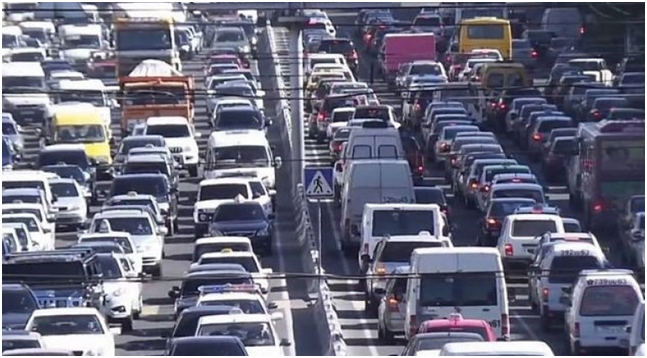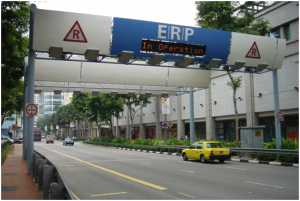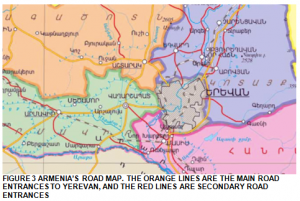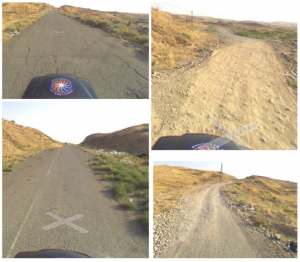
Traffic Congestion and Yerevan: Alternatives That Can Unload the City
Author: Nairi Aristakesyan
Abstract
This policy paper aims to suggest options that can facilitate overloaded traffic in Yerevan. It discusses an international examples, especially concentrating on Singapore’s traffic improvement policies. Based on these policies, the paper suggests five alternatives appropriate for implementation in Yerevan and gives recommendations.
Introduction
In 2019, the number of vehicles imported to Armenia increased almost three times, from 64,000 in 2018 up to 190,000 in 2019. This type of growth of vehicles left a negative impact on Yerevan’s traffic, so the traffic should be settled appropriately to handle this tendency. That issue increases at least two huge problems. First, as most of the vehicles are older than 10-15 years, they increase environmental pollution in the city. Second is the difficulty of citizen’s movement from one point to another. The reasons for traffic congestion are various: poor traffic management, lack of a sufficient number of roads detouring Yerevan, the growing number of car imports, population density, poor public transportation infrastructure, etc. Thus, this policy paper aims to find a possible solution for reducing traffic congestion in Yerevan. The method of the paper is a content analysis of data sources and visual analysis of maps, photos of motorways, etc. It also includes a case study that discusses the schemes being successfully implemented in Singapore and, based on these schemes, will suggest alternatives that likely will decrease traffic congestion in Yerevan. The main stakeholders of this policy paper are the Municipality of Yerevan and the Ministry of Territorial Administration and Infrastructure.
Background
The growth of the vehicles increased due to the popularity of purchasing used cars at auctions of developed countries, such as the U.S or Japan, which allowed buying automobiles with incomparably low prices than the local market was suggesting. Many Armenians started to do business by importing cars and then selling them to the local clients or clients from the Eurasian Economic Union states.
The boom of vehicle imports in 2019 is mostly connected with the expected increase in custom clearance fee. Started from January 2020, after the entry into force the EAEU customs duty rates, the customs clearance fee of vehicles depends on the year of production and the car engine capacity. These changes will probably weaken the wave of car imports; however, the vast quantity of vehicles already in Yerevan raises a necessity to perform policies that will improve the traffic congestions.
Policy alternatives
The main international example that will be presented in the paper is Singapore’s transportation improvements, and other examples also will be discussed during the suggestions of alternatives for Yerevan.
Singapore’s transportation is one of the most well-developed systems in the world. The improvements in Singapore started from the 1970s when the traffic started to become overwhelmed. Since then, Singapore’s government started to implement some schemes and techniques that significantly reduced traffic congestion in this city-state. One successful improvement of traffic congestions was the “Area Licensing Scheme,” which aimed at creating restriction zones in the city. The entrance of vehicles in these zones during the determinate rush hours required a manual fee payment (the exception was an emergency vehicle). However, as the number of cars increased during the time, it became complicated to actualize manual payments. Thus the government decided to replace the Area Licensing Scheme with Electronic Road Placing (ERP) system. This system undeniably made the payment process easier and did not become a headache for vehicle drivers. There is both cordons based and point-based ERP systems in Singapore. The cordon based ERP means the charge of the driver for daily entrance to the specific area, while point-based ERP is set for passing the certain road point, or in other words, to drive through the chargeable street.
How do the citizens pay for driving through the roads furnished by ERP system? It is straightforward and fast. The vehicles using the ERP-covered roads should be equipped with the smart cards that must be installed in the front of the vehicle. The system automatically charges from the usage fee of the driver whenever the vehicle passes next to the ERP system and enters to the chargeable zone. In addition to this, the ERP takes the photos of each vehicle entering the chargeable zone to determine violations implemented by drivers. The violations can be the absence of a smart card or the lack of credit within the smart card. In these cases, the registered vehicle-owners receive a letter of payment the entrance fee and administrative fine. The prices of ERP are different and depend on the equivalent of the passenger car unit (see figure 2), the place of the ERP system is situated, and the hour of the passing the gantry.

Figure 1 ERB system gantry in Singapore

Figure 2 Vehicle type and the passenger car unit in Singapore
This kind of transportation project requires a high percentage of public approval. Singapore’s government could gain the support of its citizens by explaining the whole process and what
benefits people will gain from this project, discussing with people the anticipated prices for checkpoints and getting feedback of people related to the drawbacks.
Since May 1990, Singapore adopted a vehicle quota system as well. This system, together with the ERP system is one of the main bases of traffic management in Singapore. Under this system, the citizens who want to import or buy a vehicle must apply for the certificate of entitlement (COE). A person cannot purchase or drive a car without obtaining this certificate. The government established the annual quota of vehicles in order to provide no more than 3% of annual vehicle growth in Singapore. The prices of the certificate are considerably high. It depends on the car’s power by brake horsepowers (bhp). For instance, a COE for average sedan car is from $30,000 to $50,000. In addition to this, the taxes and fees on vehicles also very high in Singapore. An import fee is 130% of the vehicle’s open-market price, and the importer should pay a 20% excise tax and registration fee of $90. This amount of tax rates are significantly higher compared with most of other country’s customs clearance fee, which makes car-owning in Singapore vastly expensive.
Parking spaces are managed by the government, and the charges of public parking have been increased to dispirit people driving. As a response to this kind of restriction, Singapore’s government established free parking spaces next to the transport stations, which allowed people to park their cars and travel by public transport. They also developed a well-organized public transportation system.
Singapore’s case raises some policy alternatives for implementation in Yerevan that will be discussed below.
Alternative 1: Electronic Road Pricing System for Entry to Yerevan
The majority of Armenia’s population is concentrated on Yerevan. According to the 2011 census, the number of citizens living there is more than one million people, which is one-third of overall Armenia’s population (armstat.am). The number of people working or studying in Yerevan from marzes is the majority as well. There is not any specific data on how many vehicles are entering from marzes. However, if we will take into consideration that the leading universities of Armenia, most of the major manufactures and governmental institutions are concentrated in the capital city, it is logical that the flow from the regions to Yerevan is also high. This excessive concentration on Yerevan is another reason for traffic congestions. The previous government of Armenia discussed the possibility of moving some of the governmental agencies from Yerevan to other cities to decentralize the capital. Yet no steps performed to implement this policy.
In these conditions, the first alternative is to make the main entrance roads to Yerevan chargeable, by establishing Electronic Road Pricing system checkpoints. From the traffic management perspective, drivers should buy the tickets before approaching checkpoints (tickets will be sold in markets, shops, gas stations, etc.) and install them on the windshield of the car, which will give them an opportunity to enter Yerevan. Or, there will be suggested a more practical option, which is the installation of smart cards on the in-vehicle unit of the cars. The ERP system will make the payment automatically while the car is passing. The system will take photos of cars, which means drivers that miss having a ticket or a sufficient balance on their smart cards will be subject to an administrative fine.
The entrance fee should be different depending on the vehicle type and size. For instance, the price will be dependent on the passenger car unit (PCU). Similar to Singapore’s case, cars and lightweight goods vehicles will be estimated as 1 PCU, motorcycles will be 0,5 PCU, and (very) heavy goods vehicles and (big) buses will be estimated as 1,5 PCU. It is difficult to suggest a price for the entrance fee that will be an effective way to decrease traffic congestion and not just another option to tax people. Meanwhile, according to the Statistical Committee of the RA, the average amount of salary in January 2020 was approximately 191,000 drams ($397) in Armenia, which means 6366 drams average daily salary (https://www.armstat.am/am/?nid=12&id=08001). If we consider this number as the average amount of the wages in Armenia, it is logical to set the fee 600 drams ($1,25), which is almost 10% of the daily average wage. The ERPs will be in operation during the morning rush hours only, from 8 a.m. to 11 a.m. This means that the entrance to Yerevan will be free after 11 a.m, and in addition to this fees will be removed on weekends and holidays as well. Public transports (buses) and emergency vehicles will be exempted from the charges. To avoid the increasing prices of products imported from the factories positioned in the regions, the government will provide a license to the vehicles registered in a particular factory and exempt them from the entrance fees. This kind of license can be provided to taxi and delivery services as well.
To avoid the increasing prices of products imported from the factories positioned in the regions, the government will provide a license to the vehicles registered in a particular factory and exempt them from the entrance fees. This kind of license can be provided to taxi and delivery services as well.
While implementing this policy, it is important to look at the main and secondary roads connecting Yerevan with neighboring marzes. There are four marzes that have direct road communication with Yerevan: Ararat, Aragatsotn, Kotayq and Armavir. The main road that connects Ararat region with Yerevan is M-2 motorway, which also connects Yerevan to Vayots Dzor, Syunik, and Iran border. The motorway is one of the two main roads connecting Stepanakert to Yerevan as well. There are another three small roads connecting Yerevan and Ararat region. One passes through Yerevan’s Nubarashen district, second is connecting south-western part of Yerevan to Masis town, and the third road is a parallel to the M-2 motorway and joins the motorway before entering to Yerevan.
Other three marzes also communicate with Yerevan mostly by interstate motorways. Yerevan is connected with Aragatsotn and Armavir by M-1( Yerevan-Gyumri-Bavra-Georgia border) and M-5 ( Yerevan-Echmiadzin-Armavir-Turkey border) motorways accordingly. There are no data about alternative roads directly communicating these two regions with Yerevan, nor they can bee seen on the map. Kotayk’s main road connection is via M-4 (Yerevan-Sevan-Ijevan-border) interstate motorway. However there are two alternative roads connecting the region with Yerevan: one connects Abovyan to Nor-Nork district and the other connects Yeghvard to Davtashen district.
This project will establish an ERP system on the main entrances only, to leave an alternative entrance opportunities for citizens. The positive implications of this policy are that many people will avoid using their cars for entering Yerevan, which will significantly decrease the number of vehicles and increase the demand for public transports and railway systems. However, there are at least two difficulties for the implementation of this policy. One is the preparation of citizens to the policy since the majority of people living in regions (marzes) will be against these improvements. The preparation will require a long period and should include media campaigns, demonstrating scenes of the extremely overloaded traffics and explanations of its irreversible consequences on the environment and people’s health. In addition to this, the project will become more acceptable if the government will provide people an in-detail explanation of the planned actions and its positive implications on traffic congestion, taking into consideration feedbacks of the society before implementation. The second is the improvement of the public transportation and railway systems connecting marzes to Yerevan, and public transportation within Yerevan, to make them willing to serve a sufficient number of people. These improvements also require additional high expenses for the government.
Alternative 2: Roads detouring Yerevan
Another reasonable option to reduce traffic congestion in Yerevan is to establish bypasses around the capital city. The similar project presented the government of Georgia, which aimed to construct a 20km long road that will detour the capital Tbilisi, making the travel by Georgia more convenient and reduce the traffic congestion in Tbilisi. This kind of alternative can be discussed for Yerevan as well.
Figure 4 — Photos of M-15 Motorway retrieved from Google maps
If we are taking a glimpse of the road map (figure 3), there is only one main road that detours Yerevan. The road is directed from Masis town to Balahovit village. That road is M-15 highway, which has been established during the Soviet Union and since then never been repaired. In order to understand the condition of this road, I decided to look at photos provided by google maps. If we look at these photos, the road is, to say the least, in a poor condition (figure 4).
It is noticeable that overall the road is semi-asphalted. In some parts, the asphalt is suddenly interrupted with dirt roads, which seems to be a result of landslide and indicates the unstable geological condition of the motorway. This can be the main reason that the government avoids to repair this road. It is not difficult to find out the possibility of solving this problem by doing geodesy. If it is possible to solve these landslide problems, it will be reasonable to repair this existing motorway and not construct a new one. First, the construction of a new motorway requires additional spendings for purchasing the lands, as the government needs to nationalize the private lands that the road will pass through. Second, repairing the existing road is more time-efficient than the construction of new one. Third, If we look at Figure 3, it seems that this road is the most geographically convenient and the most effective option to both reduce the traffic congestion in Yerevan and connect M-2 and M-4 highways. Although there is one similar existing road that passes through “Sari Tagh” district and detours the downtown of Yerevan, however the road is narrow and often overloaded. The M-15 motorway starts from M-2 interstate motorway and interrupts by joining to M-4 another interstate motorway. Even repair works that should be carried out regularly to eliminate damaged sections of the road as a result of a landslide will be a reasonable cost in comparison with the obtained efficiency of this road in unloading Yerevan traffic.
Alternative 3: Increase Parking Fees in the downtown of Yerevan
The third alternative is to increase the charges of public parking. In Yerevan, for one-hour parking in “red lines” parking spaces worth 150 drams and approximately 750 drams for entire day parking. To discourage people from driving cars in the Small Center district, where the majority of government agencies and business offices are concentrated, the parking charges should be increased in this part of the city. The suggested price for one-hour parking will be 350 drams, and the charge for the entire day will be 1500 drams. If now the annual charge of parking is 12,000 drams, the new policy requires 20,000 drams of annual parking charges in the entire Yerevan.
Alternative 4: “Park and Ride System”
Another alternative is the implementation of a “park and ride system,” which aims to make free parking spaces for vehicles nearby bus and metro stations. This will encourage people to park their cars and travel by public transport. This system will be effective in the case of the increase the charges of parking spaces and improvement of the transportation system.
Alternative 5: “Vehicle Quota” System
This alternative suggests the experience of the “Vehicle Quota” system. As it is explained in the case of Singapore, the citizens should bid for a certificate that will allow them to purchase a vehicle. It means that besides driving licenses, citizens should receive a particular certification that will enable them to buy a car. The validity of this certificate is ten years, and after the expiration date, drivers should apply for a license again. However, these certificates should not be as expensive as they are in Singapore. As I already mentioned, for average sedan cars, Singapore’s people should pay from $30.000 to $50.000. In Armenia, the prices for the certificate should not be as high. It is difficult to estimate how much will be the most acceptable amount of money for this certificate, however in this case also the price should be discouraging for the majority of people to obtain a vehicle. I think it should not be more than $2500. The certificates should be restricted in number, and drivers should apply to bid the certificate in “first come first served” principle. The main idea of this policy is to control the growth of vehicles in the country and do not let the number of cars increase to the problematic and uncontrollable level.
Conclusions and recommendations
Singapore’s case demonstrates that these alternatives are necessary options to improve traffic congestion. Although the options are discussed separately for Yerevan’s instance, it will be much effective if the government will implement these five suggested options gradually, and not only one or two of them. All of these alternatives aim to reduce the congestion level and control the traffic simultaneously. However, most of these options require a well-developed public transportation system, the issue that is not correctly solved yet in Armenia.
I decided to distribute the policy alternatives by their duration of implementation. There are short-term (1-2 years), midterm( 2-5) years, and long-term (5-10) available policies. One of the most effective options is the “ Electronic Road Pricing System for Entry to Yerevan”, which I consider to be a feasible long-term alternative. There are several reasons for this. First, public transportation is not ready for this policy and needs to be properly settled, especially the transportation infrastructure connecting Yerevan to regions. Second, this option will raise comparatively higher discontent among society. In the case of proper explanation of the problem to the society, the dissatisfaction may be less than it is anticipated; however, it will take enough long period of time.
The detouring roads are necessary and vastly effective options to unload Yerevan’s traffic. It can be either the new highway or the reconstruction of the M-15 motorway. I do not see any troubles to implement this policy; thus, I consider it as a feasible mid-term policy.
The “Increase the Parking Fees in the Downtown of Yerevan” and “Park and Ride System” alternatives also can discourage people from driving a car and use public transport. However, in my opinion, the most provocative, but at the same time, the effective option is the “Vehicle Quota” System. This is the best option to control the number of cars in the state and discourage families from having more than one car, as it makes owning a vehicle a luxury property not available to everyone.
Bibliography
- Union of Informed Citizens, (2019). Started from 2020, the Custom Clearance fee will increase for 6 times. Retrieved from: https://uic.am/7341
- RA 2011 census results. (n.d.) Retrived from: https://armstat.am/am/?nid=532
- Economic and Social Commission for Asia and the Pacific, (n.d.). Controlling traffic through policy: Singapore’s traffic policy package. Retrived from: https://www.unescap.org/sites/default/files/40.%20CS-Singapore-traffic-policy-package.pdf
- (n.d.). Retrieved from http://documents.worldbank.org/curated/en/514871467993172515/pdf/104686-WP-PUBLIC-2006-08-The-Singapore-Area-Licensing-Scheme-1975.pdf
- In 2019, the number of cars imported to Armenia has tripled.(2020) retried https://b24.am/economy/80021.html
- Road Map.(n.d.). http://ard.am/ճանապարհային-քարտեզ/
- Institute for Transportation and Development Policy, Institute for Transportation and Development Policy, & Institute for Transportation. (2018, July 20). The Case for Electronic Road Pricing. Retrieved from https://development.asia/case-study/case-electronic-road-pricing
- S. B. Ohanyan, N. T. Barseghyan, Problems of regulating the development of the adjacent main road territories in the zones of urban influence in Yerevan, Bulletin of National University of Architectur and Construction of Armenia, 2016, Issue 1. Retrived from http://www.mathnet.ru/links/ba2a1249b21ffef9bf438d101b3ff6dd/nuaca70.pdf
- New bypass around Georgia’s capital Tbilisi announced. (n.d.). Retrieved from https://agenda.ge/en/news/2016/1565
- (n.d.). Retrieved from https://www.google.com/maps/@40.1303204,44.5758943,16z
- Chronological series. (n.d.). Retrieved from https://www.armstat.am/am/?nid=12&id=08001


